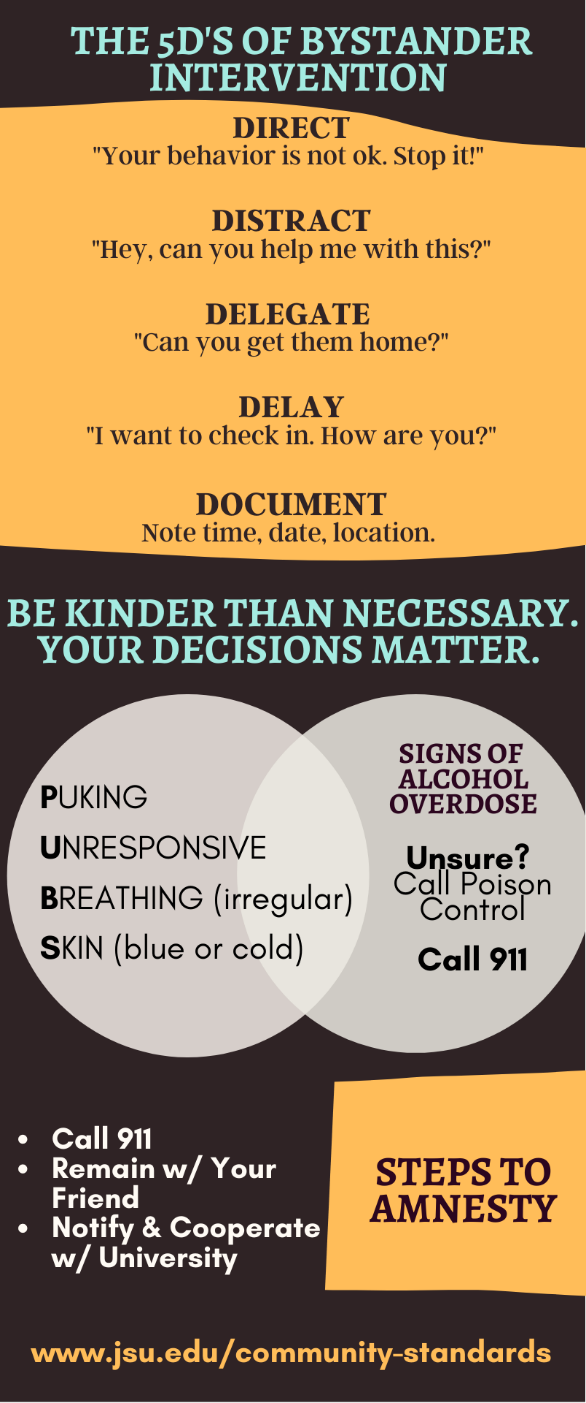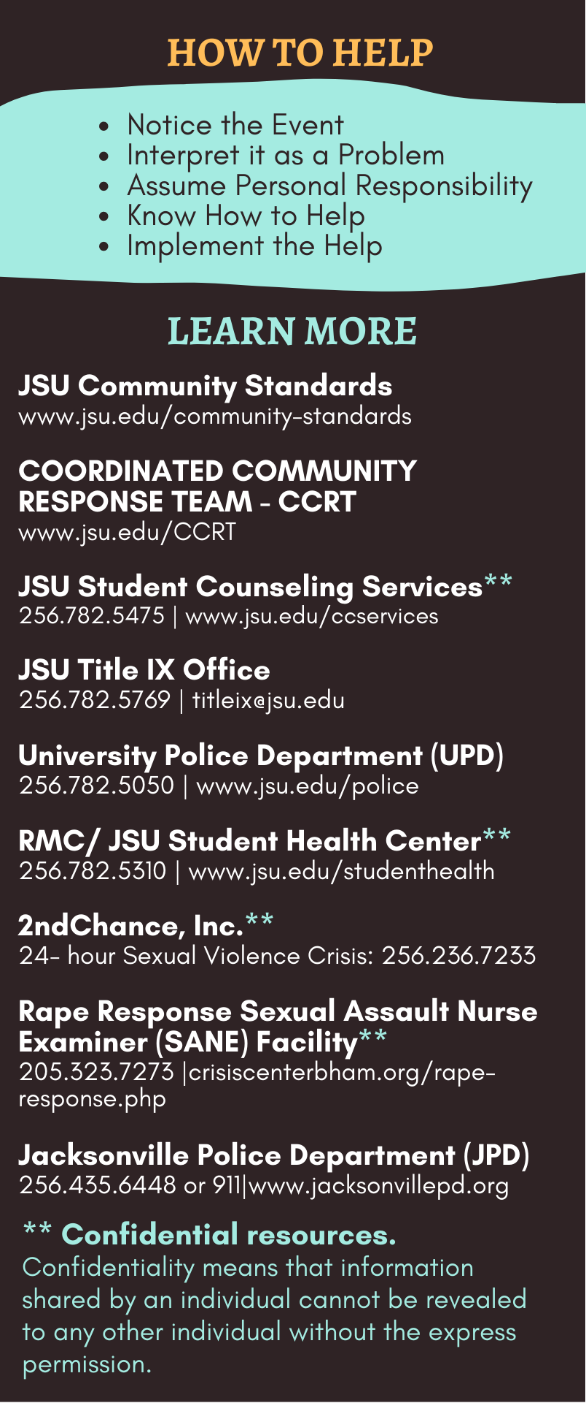Be the Friend. Bystander Intervention
Bystander Intervention is recognizing a potentially harmful situation or interaction and choosing to respond in a way that could positively influence the outcome.
Request Bringing in the Bystander Training
There are five steps to helping when witness to a problematic or potentially problematic situation.
- Notice the Event: It’s easy to be distracted and not aware of your surroundings. Pay attention to what is going on around you.
- Interpret It as a Problem: After you notice something is going on, you may need to assess the situation. You may ask others for clarification, gather other facts and opinions on what is going on, and determine if the problem requires intervention. Don’t be sidetracked by ambiguity, conformity or peer pressure.
- Assume Personal Responsibility: It is important to assume responsibility for the situation. If not you, then who? Do not assume someone else will do something. Develop a game plan and think about what will happened when you help.
- Know How to Help: How are you going to help? What intervention strategies will you use of the 5D’s of Bystander Intervention? NEVER put yourself in harm’s way but DO SOMETHING! Help can be direct or indirect.
- Implement the Help: Act! If not you, then who?
5Ds of Bystander Intervention
You may want to directly respond to harassment by naming what is happening or confronting the harasser.
- “That’s inappropriate, disrespectful, not okay, etc.”
- “Leave them alone.”
- “That’s homophobic, racist, (insert type of harassment), etc.”
The aim here is simply to derail the incident by interrupting it. The idea is to ignore the harasser and engage directly with the person who is being targeted. Don’t talk about or refer to the harassment. Instead, talk about something completely unrelated.
- Pretend to be lost. Ask for the time. Pretend you know the person being harassed. Talk to them about something random and take attention off of the harasser.
- Get in the way. Continue what you were doing, but get between the harasser and the target.
- Accidentally-on-purpose spill your coffee, the change in your wallet, or make a commotion.
Ask for assistance, for a resource, or for help from a third party.
- Find the store supervisor, bus driver, or a transit employee and ask them to intervene.
- If you’re near a school, contact a teacher or someone at the front desk. On a college campus, contact campus security or someone at the front desk of a university building.
- Get your friend on board.
- Speak to someone near you who notices what’s happening.
- Call 911 (if it is safe) to request help.
You can wait until the situation is over and speak to the person who was targeted.
- Ask them if they’re okay and tell them you’re sorry that happened to them.
- Ask them if there’s any way you can support them.
- Offer to accompany them to their destination or sit with them for awhile.
- Share resources with them and offer to help them make a report if they want to.
- If you’ve documented the incident, ask them if they want you to send it to them.
Record an incident as it happens to someone.
- Keep a safe distance.
- Record street signs and landmarks that help identify the location.
- State the date and time.
- ALWAYS ask the person targeted what to do with the footage.
- NEVER share the recording online without permission.
Having Difficult Conversations
I Care
Let the person know you care about them and that because of the significance of the relationship you need to discuss something very important. Both starting and ending the discussion with an emphasis that you are doing this out of genuine concern, caring and respect for the person, sandwiches the difficult feedback between strong positives. Choose words you are comfortable with and fit your style.
“John, do you have a minute? Because you’re such a good friend and I really care about you, I want to talk to you about something very important.”
I See
Report/Review actual events with your friend, as you perceive them. Remember you are evaluating the behavior not the person. Try to limit your statements to observable, irrefutable facts. The more you have, the better.
“I’ve been noticing that you are not going to class as much and your practices haven’t been as productive lately. From my perspective, you really don’t seem to be yourself. I’ve seen you drinking more when we go out and it seems to be more frequent than in the past. You even got into that fight last weekend at the party and I’ve never seen that from you before.”
I Feel
Tell the person your own feelings using “I statements” to reveal your feelings.
“I’m worried about how it is affecting you — personally, in school and on the team. To be honest I’m also scared about what could happen to you.”
I Want
Tell the person what you would like to see happen.
“John, I want what’s best for you and the team. I’d like to see you get some help – and sooner rather than later — at least talk to someone — either Coach Jones or even someone at our Counseling Center. You have so much to offer and the team really needs you! I’d really hate for something bad to happen because of a poor decision.”
I Will
Specify what you will or will not do. Only set ultimatums if you can, and will, stick to them.
“I’d be willing to go with you if you want. I want to support you however I can because I respect you and you are very important to me — and to the team — but I will not lie for you and I will not watch you continue to make unhealthy choices. I’m really concerned John.”
Adapted from University of Massachusetts, Amherst Health Services, Virginia Alcohol Safety Action Program, and The BACCHUS Network.
Other possible phrases to which to confront a teammate or another person:
- “The team needs you and expects more from you.”
- “This is JSU. That is not what we are about.”
- “I know you are better than that.”
- “You know that’s not OK.”
- Make the target goal inflexible but the process to reach it flexible.
- Be curious/ask questions to understand from their point of view. (Perspective taking)
- Use contrasting to clarify misunderstandings. (e.g. What I DON’T want is X, what I DO want is Y).
- Ask permission if the topic is sensitive.
- Avoid “absolutes” (always, never, etc.)
- Avoid gossiping and rumor spreading.
- Be ready for a negative reaction. People can feel attacked when confronted and can get angry. Assure them that you are care about them and are concerned about their behavior.
- Take care of yourself — it can be difficult on helpers as well.
- Follow up.
Learn more about Bystander Intervention
Learn more about your Conflict Resolution Style
Peacebuilding Toolkit, United States Institute of Peace





